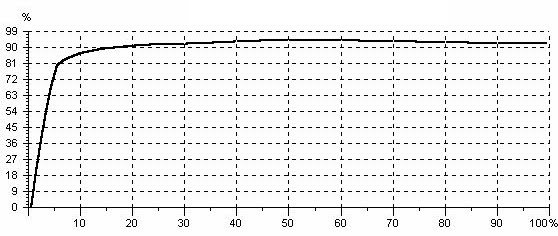Inverters
The inverter has two functions:
- The DC voltage generated by the PV modules is transformed to AC voltage and frequency of the public power grid (DC/AC conversion).
- The integrated MPP tracker for operating the PV generator at maximum power point (MPP).
DC/AC conversion
The conversion from DC to AC voltage is lossy. Determines PV*SOL® the output power as a function of the input power via the efficiency characteristic.
The figure shows the typical course of relative efficiency. The output power $P_\text{AC}$ of the inverter is calculated as follows:
$$ P_\text{AC} = P_\text{DC} \cdot \eta_\text{Nenn} \cdot \eta_\text{rel} $$
$P_\text{DC}$: Module power
$\eta_\text{Nenn}$: Efficiency at nominal power
$\eta_\text{rel}$: Relative efficiency
MPP-Tracking
To simulate the MPP tracking of the inverter, the program checks in each simulation step whether the module MPP voltage can be set by the inverter.
If the MPP voltage is outside the MPP tracking range of the inverter, the controller continues to run the U-I characteristics of the modules until the operating point at which the maximum power can be drawn is found.
For further information, see Check for current, voltage and power limits
Further losses
Along with the efficiency characteristic of the inverter PV*SOL® takes into account
- the MPP adjustment efficiencies,
- standby and night consumption
- and the input power threshold above which the inverter delivers power.
All factors are taken into account in the system efficiency.
See also
